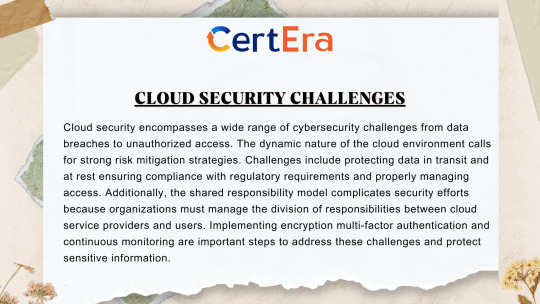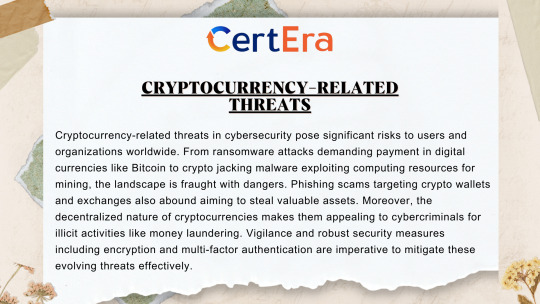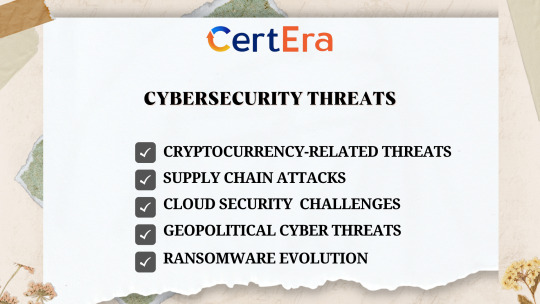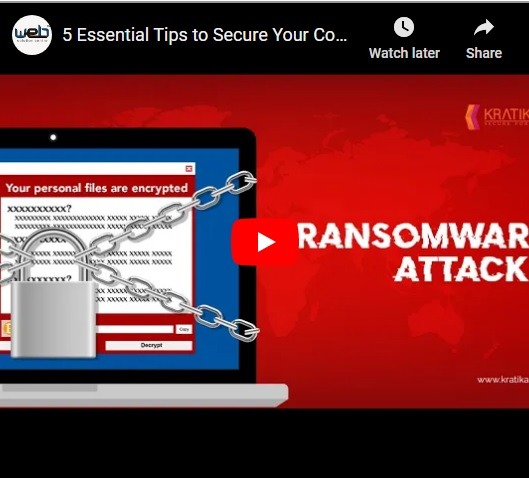#CybersecurityThreats
Text
Apply to the top ethical hacking coaching institute in Thane! You will learn cybersecurity skills through our knowledgeable professors and practical instruction. Enroll today to ensure a safe future!
0 notes
Text
#itcompanydubai#CybersecurityThreats#Cybersecurity Trends#Cybersecurity Mitigation#Data Protection#Cyber Defense#Information Security#Cyber Risk Management#Cyber Awareness#Threat Detection#Security Strategies
0 notes
Text







#CybersecurityThreats#BusinessSecurity#CyberAttacks#DataBreach#Ransomware#Phishing#Malware#SocialEngineering#IoTSecurity#CloudSecurity#SupplyChainSecurity#AIinCybersecurity#ZeroDayExploits#CyberResilience#EndpointSecurity#CyberHygiene#InsiderThreats#CyberCrime#DataPrivacy#IdentityTheft#CyberInsurance#ThreatIntelligence#PatchManagement#BusinessContinuity#CyberSecurityAwareness#Encryption#MultiFactorAuthentication#CyberSecurityStrategy#Certera
0 notes
Text
Automotive Cybersecurity Market 2024 to 2030 Introducing New Industry Dynamics

The qualitative report published by Exactitude Consultancy research on the “Automotive Cybersecurity Market offers an in-depth examination of the current trends, latest expansions, conditions, market size, various drivers, limitations, and key players along with their profile details. The Automotive Cybersecurity market report offers the historical data for 2018 to 2023 and also makes available the forecast data from the year 2024 to 2030 which is based on revenue. With the help of all this information research report helps the Market contributors to expand their market positions. With the benefit of all these explanations, this market research report recommends a business strategy for present market participants to strengthen their role in the market. This report analyzes the impact of the Covid 19 pandemic on the Automotive Cybersecurity Market from a Global and Regional perspective.
The global automotive cybersecurity market is expected to grow at 16.4% CAGR from 2023 to 2029. It is expected to reach above USD 24.28 billion by 2029 from USD 6.24 billion in 2022.
For The Full Report Click here:
https://exactitudeconsultancy.com/reports/7483/automotive-cybersecurity-market/
#AutomotiveCybersecurity#CarSecurity#VehicleCybersecurity#CybersecurityInCars#ConnectedCarSecurity#AutoCybersecurity#CarHacking#VehicleSafety#CybersecurityThreats#AutomotiveTechnology#ConnectedVehicleSecurity#CybersecurityAwareness#CyberSafety#SecureDriving#CyberDefense#VehicleProtection#DataSecurity#CarTech#SafetyFirst#AutomotiveInnovation
0 notes
Text
Surge in “hunter-killer” malware poses significant challenge to security teams

Threat actors have stepped up their efforts over the last year to launch attacks aimed at disabling enterprise defenses, according to the annual Red Report released Tuesday by Picus Security.
https://jpmellojr.blogspot.com/2024/02/surge-in-hunter-killer-malware-poses.html
0 notes
Text
#cybersecurity#cybersecuritythreats#prevention#security#securityprevention#securitythreats#threats#gauravgo#gauravgo posts#blog
0 notes
Text
Ransomware-as-service
Discover the growing menace of Ransomware-as-a-Service (RaaS) in cybersecurity. Uncover its profound impact, intricate business model, and vital defense strategies to thwart its devastating assaults. Explore actionable insights to mitigate risks, defend against evolving threats, and leverage cutting-edge intelligence for fortified protection against RaaS attacks.
To read more on Ransomware-as-service

#RansomwareAsAService#CybersecurityThreats#RaaSAttacks#DefenseStrategies#CybersecurityIntelligence#MitigateRisks#CybersecurityProtection#EvolvingThreats#RansomwareDefense#DigitalSecurity#InfoSecInsights#SecurityIntelligence#CyberResilience
1 note
·
View note
Link
https://bit.ly/3REwoJG - 🔐 Zero-click attacks, requiring no user interaction, are increasingly becoming a significant cybersecurity threat. These attacks exploit vulnerabilities in messaging, SMS, and email applications, allowing threat actors to install malware such as spyware or stalkerware. This stealthy nature makes it challenging to track and stop malicious activities. #ZeroClickAttacks #CybersecurityThreats 📱 In 2019, WhatsApp was vulnerable to a zero-click attack through a missed call, demonstrating the ease with which these attacks can compromise devices. Companies are now prioritizing defense against such attacks. For instance, Samsung's Message Guard and Apple’s BlastDoor are designed to sandbox and scrutinize incoming data, reducing the risks of zero-click attacks. #WhatsAppVulnerability #MobileSecurity 🛡️ Despite advancements in anti-zero-click solutions, users must remain vigilant. Vulnerabilities can still be exploited, especially in devices with outdated software. Regular updates, using phones from brands known for security updates, and sticking to official app stores are crucial practices for protection. #DeviceSafety #CyberHygiene 📊 Basic cybersecurity tips remain essential to prevent zero-click attacks. Keeping devices and apps updated, using mobile antivirus solutions, and practicing good cybersecurity hygiene are key strategies. Regular backups can also aid in data recovery if a reset is needed. #CybersecurityTips #MobileProtection In summary, zero-click attacks present a growing challenge in mobile security, requiring both advanced technological solutions and diligent cybersecurity practices from users.
#ZeroClickAttacks#CybersecurityThreats#WhatsAppVulnerability#MobileSecurity#DeviceSafety#CyberHygiene#CybersecurityTips#MobileProtection#ZeroClickCybersecurity#DigitalSafety
0 notes
Text
Cyber Threats Surge: Kaspersky Unveils 2024 Defense

In a recent press conference held in Johannesburg, Kaspersky, a global cybersecurity leader, unveiled alarming insights into the cyber threat landscape in Africa during the third quarter of 2023. With a digital revolution in full swing, the continent is witnessing a surge in cybercrime activity, setting the stage for a challenging 2024.
Web Threats on the Rise
As organizations embrace digital transformation, the specter of web threats looms large over Africa. Kaspersky's data reveals a 24% increase in corporate users falling victim to web threats from Q2 to Q3 2023. However, the silver lining emerges when comparing year-on-year statistics, showing an 8% decline in the same period.
Battling Phishing Attacks Across Borders
One of the prevailing threats is phishing, a deceitful tactic to pilfer sensitive information. In Kenya, phishing attacks surged by 32% in Q3 2023 compared to Q2, while Nigeria experienced a 12% increase. However, a positive trend emerges when looking at year-on-year figures, with Nigeria witnessing an 8% decline in phishing attacks.
Attacks on Industrial Control Systems
Africa finds itself among the most targeted regions for attacks on Industrial Control Systems (ICS) computers. These critical systems are integral to various sectors, from energy to automotive manufacturing. In Q3 2023, Kaspersky ICS CERT reported attacks on 32% of ICS computers in Africa, with South Africa at 22%, Kenya at 28%, and Nigeria at 25%. Globally, malicious objects impacted 25% of ICS machines.
Surging Attacks on Internet of Things (IoT) Devices
The proliferation of Internet of Things (IoT) devices brings with it a surge in cyber attacks globally. In Q3 2023, South Africa saw 28% of the attacks on IoT devices detected by Kaspersky, with Kenya and Nigeria contributing 12% and 6%, respectively. Cybercriminals exploit these devices for various malicious actions, from DDoS attacks to acting as proxies.
Outlook for 2024
Bethwel Opil, Enterprise Client Lead at Kaspersky in Africa, anticipates a dynamic evolution of cyber threats in 2024. State-sponsored cyber-attacks and 'hacktivism' are poised to become norms, driven by the accessibility of generative AI. Opil warns of an upsurge in spear-phishing tactics and increased exploitation of vulnerabilities in mobile and IoT devices.
To counter these threats, Opil advises businesses to adopt advanced technologies, including threat feeds, security information, and event management systems.
Kaspersky's Recommendations for Cybersecurity
Kaspersky experts offer proactive measures to safeguard organizations:
Regular Cyber Skill Checkups and Training
Organizations are urged to conduct regular cyber skill checkups among employees, coupled with competent training. Kaspersky's Security Awareness portfolio provides flexible and scalable solutions for companies of any size.
Privacy Measures in Virtual Environments
Corporate users need education on privacy risks in virtual environments, with organizations implementing best practices to safeguard personal and corporate data.
Firmware Updates and IoT Protection
Prompt installation of firmware updates on digital devices is crucial. Additionally, Kaspersky recommends using Cyber Immune solutions for IoT protection on corporate networks.
Continuous Vulnerability Assessment
Establishing continuous vulnerability assessment and triage is crucial for effective vulnerability management. Solutions like Kaspersky Industrial CyberSecurity can be efficient assistants, providing unique actionable information.
As Africa navigates the evolving cyber threat landscape, Kaspersky emphasizes the importance of proactive measures to ensure a secure digital future.
For more information on Kaspersky's recommendations and solutions, visit Kaspersky's official website.
Sources: THX News & Kaspersky.
Read the full article
#CyberThreatOutlook2024#CybersecurityThreats#IndustrialControlSystemsAttacks#InternetofThingsAttacks#IoTProtectionSolutions#KasperskyInsights#KasperskySecurityAwareness#PhishingTrends#SouthAfricaCybercrimeReport#WebThreatLandscape
0 notes
Text
What Are Cyber Security Threats and How Do You Prevent Them
Modern business has been altered by growth of the Internet. Organizations are increasingly making news due to cyber security threats and how to prevent them. Organizations are increasingly making news due to cybersecurity breaches. Every year, these attacks cause damage to corporate networks, equipment, business processes, and data, costing companies billions of dollars in losses and missed opportunities. Today, firms must invest in deterrents to these cybersecurity dangers. Click here to know about top ten most common and costly cyber security threats today, as well as the actions a business may take to avoid them.
1 note
·
View note
Text

Unraveling the Enigma of the Akira Virus: An In-Depth Exploration
Discover the Akira Virus: Delve into its perplexing nature and unravel the mystery through a comprehensive exploration. Get insights on the enigma that is the Akira Virus here.
Source: https://bit.ly/45cHl94
#AkiraVirus#CybersecurityThreats#Malware#Ransomware#ComputerVirus#ZeroDayExploits#DataSecurity#CyberProtection#NetworkSecurity#DataEncryption#EndpointProtection#CyberDefense#PhishingAttacks#CyberSafety#InternetSecurity#DigitalPrivacy#OnlineThreats#CyberAwareness#CyberEducation#DataBackups#SecurityMeasures#CyberSecuritySolutions#ProtectYourself#DataIntegrity#DataPrivacy#Cybercrime#InternetSafetyTips
0 notes
Text
Safeguarding Your Digital World: Unraveling Authentication Vulnerabilities
In today's rapidly advancing digital era, ensuring the security of our online activities has never been more critical. As the reliance on digital platforms increases, so does the risk of falling victim to cyber threats. One of the most pressing concerns that internet users and businesses face is authentication vulnerabilities. In this article, we'll delve into the world of authentication vulnerabilities and explore measures to protect ourselves in the dynamic landscape of Web 2.0.
Understanding Authentication Vulnerabilities:
Authentication vulnerabilities refer to weaknesses in the mechanisms that verify and validate users' identities on digital platforms. These vulnerabilities expose sensitive information to unauthorized individuals, leading to potential data breaches, identity theft, and financial losses. As Web 2.0 continues to evolve with a focus on user-generated content and interactive experiences, it becomes crucial to address these vulnerabilities.
Common Authentication Vulnerabilities:
2.1. Weak Passwords: One of the most common authentication vulnerabilities arises from weak passwords. Users often choose passwords that are easy to remember but equally easy to guess. This makes it effortless for attackers to compromise accounts and gain unauthorized access.
2.2. Phishing Attacks: Phishing attacks trick users into revealing their login credentials through deceptive emails, messages, or websites that mimic legitimate platforms. As Web 2.0 encourages active engagement and social sharing, users become more susceptible to these cunning schemes.
2.3. Insecure Login Forms: Web 2.0 platforms are all about user interaction, and login forms are a common entry point for attackers. Inadequate security measures in login forms can lead to brute-force attacks and credential stuffing.
2.4. Insufficient Multi-Factor Authentication (MFA): MFA provides an additional layer of security by requiring users to provide multiple pieces of evidence to confirm their identities. Failing to implement MFA leaves accounts vulnerable to unauthorized access.
Mitigating Authentication Vulnerabilities:
3.1. Strong Password Policies: Web 2.0 platform administrators should enforce strong password policies, mandating the use of complex and unique passwords. Users must be educated about password best practices, such as avoiding common words and regularly updating their passwords.
3.2. User Awareness and Education: Raising awareness among users about phishing attacks and other social engineering tactics is crucial. Regular educational content on the platform can empower users to recognize and report suspicious activities.
3.3. Secure Coding Practices: Web 2.0 developers should prioritize secure coding practices while implementing login forms and user authentication. Input validation, data encryption, and protection against common attacks like SQL injection must be integral parts of the development process.
3.4. Multi-Factor Authentication (MFA): Implementing MFA adds an extra layer of protection, significantly reducing the risk of unauthorized access. Web 2.0 platforms should encourage users to enable MFA and make the process user-friendly.
Conclusion:
Authentication vulnerabilities pose a significant threat to the security and integrity of Web 2.0 platforms. As users actively engage in content creation and social interaction, safeguarding their digital identities becomes paramount. By understanding the common authentication vulnerabilities and adopting proactive security measures, both platform administrators and users can collaboratively create a safer digital environment. Embracing strong password practices, promoting user awareness, employing secure coding practices, and implementing MFA will fortify the foundations of Web 2.0, ensuring a more secure and enjoyable online experience for all.
#Authentication vulnerabilities#CyberSecurityThreats#WebSecurity#PasswordSecurity#PhishingAttacks#UserAuthentication#DataBreachRisk#MultiFactorAuthentication#Web2Security#OnlineIdentityProtection#SecureLoginPractices#UserAwareness#DigitalIdentitySecurity#WebDevelopmentSecurity#ProtectYourAccounts#OnlineSafetyTips#DataPrivacy#SecurityBestPractices#CyberThreats#IdentityTheftPrevention
1 note
·
View note
Text
some tips to help your personal information secure on social media???
The original purpose of social media was to bring people together.
We share our lives with our far-away loved ones and friends and make new friends across time zones and cultural boundaries all over the world.
Keep apps updated
App updates improve the security of our device and therefore help to keep our personal information safe.
If apps are not up to date then hackers can target us a lot more easily and gain access to our personal information.
So we need to turn on automatic updates so that we wouldn't be worry again! after, the new update could provide an overall more enjoyable experience for users.
Application updates are made with improvements and growth in mind. There is no reason as to why we shouldn't hesitate to keep our apps updated.
2.Create strong passwords
Cyber criminals know that most people create passwords that are easy to remember and will often reuse the same password across multiple accounts. Because of this, all it takes is hacking into one account to quickly access the rest of them.
But with remote workforces becoming the new normal and a sharp increase in the amount of information exchanged digitally daily,organizations worldwide remind their end users of the importance of a strong password.
strong password best practices must be everyone’s priority year-round.
3.Use strong passwords and 2FA
There are many ways a cybercriminal can crack, hack, or otherwise obtain our password.
They may use specialized cracking software, ensnare you in a phishing campaign,
or scour your social media posts for clues.
But often, they’ll simply buy our passwords on the dark web.
Password hacking is a lucrative business, and if you’ve been using the same password for years and on multiple sites,
it’s likely to have already been compromised.Hackers will steal user credentials as part of a data breach, compile all the info into a massive list,
then sell it to other cybercriminals to use in their own schemes.
4.Use private Wi-Fi
It’s handy, simple and relatively cheap to set up a wireless (WiFi) network in our own home. It saves us from having to connect and disconnect all sorts of wires for our computers just in order to hook up to the Internet.
To protect the privacy of our network, we could use the WiFi Protected Access (WPA), which is a new-and-improved version of the once standard Wired Equivalency Privacy (WEP) security program.
This is the option most public hotspots use, and it can be accessed by signing in with a password. Alternatively,
we can set up a Media Access Control (MAC) address-filtering program, which does not rely on passwords.
To do this, we’ll have to set up our router with a list of the specific MAC addresses on our computers.
5.Create Individual Passwords for All Accounts
Passwords are a problem. Every account should have a unique password that’s hard to guess.
But how do we remember all those unique passwords, when we have a lot of accounts? The problem gets worse if we try to make passwords that are difficult for others to guess because they're usually difficult for us to guess as well. Many people don't bother and use a single password for all their accounts that's easy to remember like 123456.
A solution like this may be convenient, but it makes it very easy for hackers to access all our accounts. we should use password manager to prevent this situation.

#cybersecurity#cybersecurityawareness#cybersecuritythreats#CyberSecurityAwarenessMonth#cybersecurityengineer#cybersecuritytraining#cybersecurityconsultant#cybersecurityprogram#cybersecurityuae#cybersecuritysummit2017#cybersecuritysummit#CyberSecurityStartup#cybersecuritymonth#cybersecuritymarathon#cybersecurityexperts#cybersecurityexpert#cybersecuritydubai#cybersecurityconvention#cybersecurityawareness01111000#cybersecurityanalyst#CybersecurityZEN
0 notes
Photo

The Psychology of Cybersecurity: Understanding How Human Behavior Affects Online Security
#Behavioralpsychology#cybercrime#cybersecurity#Cybersecurityawareness#Cybersecuritythreats#Humanbehavior#malware#Phishing#Psychology#Socialengineering
0 notes
Text
Empowering Your Business with Cutting-Edge Cyber Defense

Empowering Your Business with Cutting-Edge Cyber Defense , Stay ahead of the game and protect your digital assets with #odiware!
Odiware cybersecurity solutions and extensive industry expertise help organizations prepare, defend, identify and retrieve cyber challenges along with other aspects of the value system
Know more at - https://www.odiware.com/it-services/cyber-security/
Contact us now at - https://lnkd.in/d8u-pzJ8
For Regular Updates:
➤ Facebook: https://lnkd.in/gYFBY6gy
➤ LinkedIn: https://lnkd.in/dKUyHsxq
➤ Twitter: https://lnkd.in/g2HePPk4
➤ YouTube: https://lnkd.in/dbk_aA6R
#odiware#informationsecurity#cybersecurity#onlinesafety#businesssecurity#cyber#instacybersecurity#cybersecuritythreats#cybersecurityjobs#cybersecurityservices#cybersecurityawareness#cybersecurityexperts#cybersecurityengineer
0 notes
Text
Look out for these cybersecurity threats in 2023

Cybersecurity threats are always on the rise. Cybercriminals are moving way ahead of cybersecurity professionals, honing their skills to break through any cybersecurity walls. The recent data from many surveys show the rising threat of cyber-attacks in almost every industry.#CyberSecurity #cybersecuritythreats #cybersecuritythreats2023 #DataBreach #phishing #ransomware #Security #threats2023
Read the full article
#CyberSecurity#cybersecuritythreats#cybersecuritythreats2023#DataBreach#phishing#ransomware#Security#threats2023
0 notes